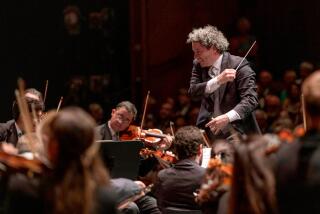Review: Dudamel, L.A. Phil scale down amid Andsnes’ elegant Beethoven
Three years ago the Norwegian pianist Leif Ove Andsnes began a “Beethoven Journey,” a four-year project devoted to performing and exploring Beethoven’s music for piano and orchestra. He has toured and recorded the five piano concertos and Choral Fantasy, conducting the Mahler Chamber Orchestra from the keyboard.
The pianist has also partnered with others, including Gustavo Dudamel and the Los Angeles Philharmonic. On Thursday night at Walt Disney Concert Hall, they reached the last segment, the Fifth Piano Concerto (“Emperor”) and the Choral Fantasy.
This is a path exceedingly well trod. Beethoven’s concertos are, and have always been, in the repertory of nearly all concert pianists. Concerto cycles are commonplace. We have long passed the time of pioneering new approaches to these centuries-old faves, and a four-year project from a pianist known for having an inquiring mind seems oddly unadventurous.
Andsnes, though, seeks freshness through clarity and care. He plays with cool eloquence. He purposefully balances every note against every other. He studiously avoids eccentricity. Looking through scrupulously clean lenses, he takes in familiar landscapes with new eyes if not new ideas. Another metaphor to his approach might be watching a restored old movie in the latest ultra-high-definition format.
That’s one kind of journey, a meticulously plotted outing of rediscovery. You hope to notice details you may have missed previously and maybe learn something new. There is comfort in such a utilitarian approach, but there is also little excitement in always knowing where you are going and how to get there.
Thursday, then, would have been an uneventful night of Beethoven had there not been the intimations of other journeys, the kind where you don’t know where the path will lead. That is certainly the case with Dudamel’s evolving approach to Beethoven.
And Dudamel’s to John Adams. The news of the evening was placing John Adams’ “Harmonium” for chorus and orchestra between the two Beethoven works.
Completed in 1981 and premiered by the San Francisco Symphony and Chorus, “Harmonium” was Adams’ first major commission. A kind of choral symphony using poems by John Donne and Emily Dickinson, it is the first work to show Adams’ flair for orchestral writing, and it can also now be understood as the beginning of his journey as a dramatic composer.
“I have no memory of what kind of pieces I imagined would follow ‘Harmonium,’ ” Adams writes in his autobiography. What, in fact, followed over the next decade, and came directly out of the stylistic innovations of “Harmonium,” were two groundbreaking operas — “Nixon in China” and “The Death of Klinghoffer.”
“Harmonium” begins with soft, muttered, pulsating repetitions by the chorus on the word “no,” which becomes “ne” and then “never” for Donne’s “Negative Love,” the first of several swirling, growing orchestral swells. The middle movement is a mysterious setting of Dickinson’s “Because I Could Not Stop for Death.” Her “Wild Nights” gets a wild ride for the last movement.
Curiously, there is a Beethoven connection here. Adams’ choral writing was a unique combination of Beethoven and Philip Glass. And the San Francisco Symphony happened to pair Alfred Brendel playing Beethoven’s “Emperor” with the “Harmonium” premiere.
Dudamel’s first time with “Harmonium” was nuanced and forceful; the Los Angeles Master Chorale was the chorus. The conductor’s way with Beethoven was also nuanced and forceful. But in keeping with Andsnes’ understated, chamber-like Beethoven, less forceful than typical of Dudamel. L.A. Phil timpanist Joseph Pereira, for instance, played early 19th century kettledrums instead of the bigger modern instruments.
Dudamel scaled everything down. He focused on crisp phrasing, with sharp percussive attack and less string vibrato than he usually asks for. But he also brought a welcome impetuosity and commanding propulsion that any successful emperor or “Emperor” demands.
The strange 20-minute Choral Fantasy is a predecessor for Beethoven’s Ninth Symphony. It begins with what was originally a piano improvisation in which Beethoven seems to be getting his compositional juices flowing. It ends in choral ecstasy, trying out what would become the “Ode to Joy” theme. In some ways, the Fantasy is to the Ninth as “Harmonium” is to “Nixon in China.”
This is a piece with which to go a little crazy. Andsnes is too reticent for that, but beautiful playing is beautiful playing, and you can never get too much of Andsnes’ elegance. Nor can you get too much of Dudamel’s capacity to convey joy or to whip the Master Chorale and L.A. Phil into the high exuberant mode that ultimately made the performance soar.
Twitter: @markswed
------------
Los Angeles Philharmonic
Where: Walt Disney Concert Hall
When: 8 p.m. Friday and Saturday and 2 p.m. Sunday
Cost: $26.50-$212
Info: (323) 850-2000, www.laphil.org
More to Read
The biggest entertainment stories
Get our big stories about Hollywood, film, television, music, arts, culture and more right in your inbox as soon as they publish.
You may occasionally receive promotional content from the Los Angeles Times.











